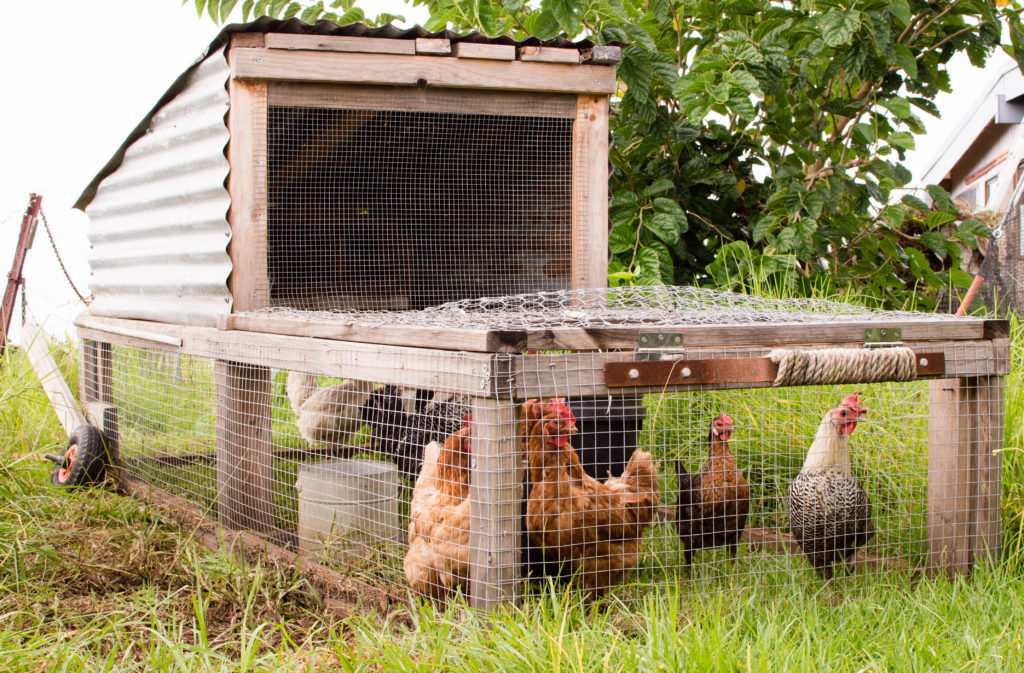It’s spring time when lots of folks are getting their first chickens, or are adding more birds to their flocks. Blogger Claire Woods shares tips for coop building materials.

Young chicken keepers at work. Photo by Steve Debenport.
While dreaming up your ideal chicken coop, you know you want it to be safe, functional, and probably pleasing to look at. Chicken lovers are coming up with more and more innovative ways of making chicken coops. Depending on your budget, and your resources, you can build a chicken coop out of almost anything. The best part is, your ladies aren’t going to be picky about your design. I have built countless chicken coops and have tried pretty much every material listed below. Every one has its advantages and disadvantages. There are countless chicken coop plans that can be found with instructions for your preferred build.
Here are some of the best materials used for constructing a quality chicken coop:
Sturdy Lumber
Lumber is an excellent choice for a sturdy chicken coop that will withstand the elements, and the wear and tear from your flock. Lumber tends to be a bit costly, so that is something to consider when selecting the primary materials you will use for your coop. Because most lumber is treated with pesticides and other chemicals to prevent it from rotting, some chicken owners opt for woods that are untreated and naturally resistant to decay. When in doubt, try to stay away from anything treated with chemical or other harmful substances.

Plywood is a cheap, and accessible material to use when constructing a chicken coop. However, it will not last as long as other woods, so ensuring that the sides that will be exposed to the weather are treated in some way is extremely important.

Using lumber to build the frame. Then cover it with chicken wire. Photo by Derek Oyen.
Another very important thing to note is that lumber is heavy. If you ever want to move the coop, which you most likely will, even if your shaking your head no, then consider weight.
One important note on lumber related materials. There are new materials coming out that are composites and rot proof without the chemical mix of treated lumber. They are usually costly and heavy, but most premium heavy duty chicken coops are built out of this material.
Plastic pre-fab
Some of the most innovative coops have been emerging online…at an eye-popping cost. Despite the price-tag of some pre-made coops, the plastic can be enticing due to a couple of unique characteristics. For example, plastic is easy to clean…and keep clean. Unlike wood, it does not absorb and foster the growth of bacteria as easily. Also, plastic tends to be lighter than wood, making it easier to move about the yard. The weight could also be a con for those living in windy areas; if the plastic coop is not weighted down, it can easily blow away.
PVC DIY
If you are a DIY’er, you may be attracted to the low-cost, puzzle-like quality of constructing a coop frame from PVC pipe. This type of coop will also be lightweight and easy to move about. Additionally, if you plan on growing your flock from generation to generation, PVC is easy to take apart and expand. Most likely, you will need to use materials like wood and wire for the inner parts of the coop (like the shelter), but creating the frame of the coop and run will cut down on lumber costs significantly.
Recyclers

Chicken tractor made from recycled and scrap materials. Photo by Natalie Board
If you tend to have a lot of lumber, crates, pallets, old dog houses, cabinets, or bookshelves laying around, these items can be used to create an eccentric coop. There’s nothing better than saving money by using things that are already free or being junked out by someone else. If you go this route, always make sure the items are chemical free. If you see paint chipping off, steer clear. For those who have craigslist, it can be your friend in this arena.
Other Essentials
The framework sets the stage for the base of your chicken coop. All the materials above can be combined to make a pretty outstanding chicken coop. Once your framework and shelter are complete, the final touches are the materials you will use to ensure the safety of your flock.
- Chicken Wire: If it ain’t broke, don’t fix it! Chicken wire has been used since the 1800s and to this day, coops around the world are using the same hexagonal wire to keep predators out and chickens in.
- Poultry Netting: Poultry netting is a great option to protect your chickens from aerial predators. Placing it over a run will prevent hawks and eagles from swooping down and killing your favorite hen.
- Electric Poultry Fencing: Electric fencing can be used to surround your coop or create a moveable pasture for your chickens. It is excellent for keeping predators away from your precious flock.
The beauty of a DIY chicken coop is that there is no one way to do it, and the ideas available are endless. Some materials are tried and true, and others are just breaking into the chicken coop-building scene. As long as the materials are safe and sturdy, your chickens won’t care what it looks like. Remember, dry and draft free and you have a happy chicken.
*****
Claire Woods is the editor at The Happy Chicken Coop and is a fourth-generation chicken keeper. Her love for chickens has helped educate millions in the proper care and upbringing of all the countless types of chickens. She has also authored the book “Backyard Chickens: A Practical Handbook to Raising Chickens” and looks forward to contributing more in helping everyone in this great adventure of raising chickens.












